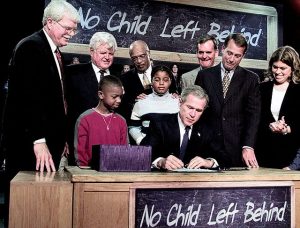By: Jackson Garner
Franklin D. Roosevelt’s New Deal policies pushed government into many sectors that it had never gone before by empowering labor unions, establishing an unprecedented amount of transfer payment programs, and creating agencies that put people to work immediately. This new wave of government intervention into citizens’ lives fueled conservative acrimony against the progressive politics of the mid twentieth century. Even though conservatives did not halt the expansion of the federal government’s role in many areas, they managed to keep education largely in the hands of state legislators during this time period. Many conservatives felt that education was the only policy arena they had left to protect. The bulwark that these old-fashioned conservatives built around keeping education out of federal hands started to crumble over the years as states were perceived as producing weak results and the federal government wanted to advance student achievement. The irony behind this is that even though liberals started forcing such reforms, conservatives slowly started to vote with them.
The War on Poverty, President Lyndon Johnson’s landmark social policy platform, elevated his key educational reform. Head Start was an all-encompassing program that attempted to help both children and parents. The idea was to not only improve education for children, but also provide employment training for parents to break the culture of poverty. Conservatives assailed this measure as too intrusive and breaking up the family unit by replacing it with government. However, the Johnson administration picked off some moderate Republicans to vote for the bill. A little over half of the GOP senators and almost 15% of the representatives voted for the bill’s approval. During this time period, new social science research, like work done by Michael Harrington in The Other America, pointed out social injustices and inequalities. The new attention given to these problems caused some members of the Republican Party to vote for more financial aid in schools.
Between 1958 and 1968, the total spending of the federal government rose from $375 million to $4.2 billion, as calculated by author Hugh Davis Graham in his book The Uncertain Triumph: Federal Education Policy in the Kennedy and Johnson Years. Once the floodgates for funding of education started to flow out of Washington, D. C., and into school districts, governors across the country were given the option to either accept or deny the money. This put many conservative governors in a bind: they could accept the money and take some of the burden off of their own coffers or stand strong on the principles they had fought to maintain for decades. The former outweighed the latter and federal dollars started pouring into their districts. Obviously, this money came with strings attached. For example, President Johnson’s Elementary and Secondary Education Act (1965) established Title I funding for needy and disadvantaged children. Even though the law explicitly stated that it didn’t create a national curriculum, states that took the money were required to create their own curriculum objectives for subjects like math and reading.
The conservatives of the New Deal era were surely rolling over in their graves on May 21, 2001 when a Republican majority passed No Child Left Behind, essentially a reauthorization of Johnson’s reform. 185 Republicans voted for the bill while only 34 rejected it. President Bush signed it into law in January of 2002. Even though the bill did increase funding for schools, that was not the most significant part of it. The increased accountability requirements, emphasis on standardized testing, and specialized training for teachers required states to adhere to federal government guidelines more stringently than ever before. Republicans and many conservatives hailed this new law as the catalyst for fundamentally changing the American education system. Just fifty years earlier, conservatives would have been frightened at the thought of such a bill.
To say that Democrats and Republicans will now always align on educational issues is not true, however. Concerns that have been raised by critics of No Child Left Behind, like over-centralization, too many tests, and “how much is too much” for funding, are still potent in political debate between the two parties today. However, modern conservatives are not debating if the federal government should have a role, because that has already been established; now the question is where to stop. The staunch line that conservatives once stood behind has been watered down. The dissolution of party colors from red and blue has turned into more of a green alignment for money.
Regardless of party affiliation, congressional leaders, governors, and school superintendents are scurrying for any federal economic help available. Programs like Race to the Top encourage states to implement innovative reforms to receive money. Initiatives like these push states to adopt more federal education policies as school districts reap the benefits.
The shift of views over the past half century by conservatives on education has reflected a cultural change in the country. As government assistance programs have increased dramatically from just a half century ago, many citizens think the federal government has a duty to ensure the nation’s youth are given every opportunity to succeed. The rhetorical question that this posed to many conservatives over the years was, “How can you deny money for students?” Even in the most red of Southern districts, politicians would have a hard time answering this question to their constituents.

